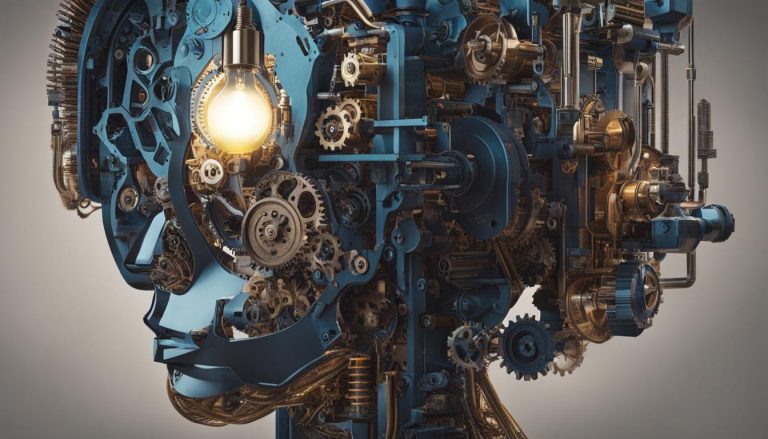Welcome to my article on connected cars! In this piece, I will dive into the fascinating world of connected car technology, also known as smart cars. So, what exactly is a connected car? Let’s find out.
A connected car refers to a vehicle that has an internet connection and is equipped with internet-enabled devices and software applications. These vehicles are rapidly becoming the future of transportation, with estimates suggesting that by 2020, one in five vehicles will have a wireless network connection. By 2022, a staggering 75% of vehicles manufactured are forecasted to be connected cars.
Vehicle connectivity relies on a combination of built-in and aftermarket technologies, offering a wide range of benefits. These include improved asset utilization, compliance adherence, performance enhancement, safety and maintenance improvement, and streamlined office functions.
Are you ready to delve deeper into the world of connected cars? Let’s explore the concept, benefits, and evolution of these groundbreaking vehicles.
Key Takeaways:
- A connected car is a vehicle with an internet connection and internet-enabled devices.
- By 2022, 75% of vehicles manufactured are expected to be connected cars.
- Connected cars offer benefits such as asset utilization, compliance adherence, and performance enhancement.
- Vehicle connectivity relies on a mix of built-in and aftermarket technologies.
- The future of vehicle connectivity involves componentization and integration with smart city technology.
What is a Connected Vehicle?
A connected vehicle is any vehicle that has an internet connection and is equipped with internet-enabled devices and software applications. It goes beyond simply being a mode of transportation and becomes a part of the digital ecosystem. Connected vehicles have the ability to transfer data from the engine, chassis, and electronics to a central data center or a driver’s smartphone, enabling a seamless and interactive experience.
To truly function as a connected vehicle, it requires an internet-enabled device, software applications, and the capability to communicate with other systems, databases, and vehicles. This connectivity can be achieved through both built-in technologies that come with the vehicle and aftermarket technologies that can be added to existing vehicles. By harnessing the power of connectivity, vehicles can provide a wide range of services and features that enhance the driving experience and improve efficiency.
Connected vehicle technology is transforming the automotive industry by enabling vehicles to gather and share data, communicate with other vehicles and infrastructure, and provide real-time information to drivers. It opens up a world of possibilities for innovation and improved functionality in areas such as navigation, safety, entertainment, and maintenance. As the adoption of connected vehicles continues to grow, we can expect to see more advanced car connectivity solutions that redefine the way we interact with our vehicles and the world around us.
“Connected vehicles have the potential to revolutionize the way we drive and interact with our vehicles. By leveraging internet connectivity and advanced technologies, we can create a more personalized and intelligent driving experience. From real-time traffic updates to remote vehicle diagnostics, the possibilities are endless.”
| Benefits of Connected Vehicles |
|---|
| Enhanced safety features |
| Improved navigation and real-time traffic updates |
| Remote vehicle diagnostics and maintenance alerts |
| Advanced entertainment and infotainment systems |
| Efficient fleet management and asset utilization |
As the automotive industry continues to embrace connected vehicle technology, we can expect to see exciting developments in the years to come. The concept of a connected vehicle will evolve, leading to greater integration with other smart systems and technologies. With advancements in Internet of Things (IoT) and 5G connectivity, we can anticipate more seamless communication between vehicles, infrastructure, and even pedestrians. The future of connected vehicles is bright, promising a new era of mobility that is safer, more efficient, and more enjoyable.
Benefits of Connected Vehicles
Connected vehicles offer numerous benefits that can greatly impact organizations and individuals alike. These benefits encompass various aspects, including improved customer service, enhanced efficiency, and optimized asset utilization. Let’s delve deeper into the key advantages of connected cars:
1. Smarter Route Planning and Utilization Tracking
Connected vehicles enable fleet managers to achieve smarter route planning by leveraging real-time data. This allows for more efficient navigation, reduced fuel consumption, and minimized travel time. Furthermore, connected cars provide accurate utilization tracking, giving fleet managers insights into how vehicles are being used. This information helps optimize routes, allocate resources effectively, and identify opportunities for cost savings.
2. Compliance Adherence and Performance Enhancement
With the connectivity features offered by connected vehicles, fleet managers can ensure compliance adherence to regulatory standards and industry-specific requirements. Real-time data from connected cars can be used to monitor factors such as vehicle speed, driver behavior, and fuel consumption. This enables fleet managers to identify any potential compliance issues and take proactive measures to address them. Additionally, connected car technology allows for performance enhancement through data-driven insights. Fleet managers can analyze vehicle performance metrics to identify areas for improvement, such as optimizing maintenance schedules and reducing downtime.
3. Enhanced Safety and Maintenance Improvement
Connected vehicles offer a range of safety features that contribute to a safer driving experience. These features include collision warning systems, automatic emergency braking, and lane departure warnings, among others. Real-time data from connected cars can also be used to detect potential maintenance issues, such as engine performance anomalies or wear on critical components. By addressing these issues early on, fleet managers can prevent breakdowns and reduce maintenance costs.
4. Streamlined Office Functions and Decision-Making
Connected vehicles provide the capability to streamline office functions by integrating with business systems and databases. This integration enables seamless communication between vehicles and the back office, facilitating tasks such as dispatching, scheduling, and data analysis. The availability of data from connected cars also allows for better decision-making. Fleet managers can leverage real-time insights to make informed decisions regarding vehicle utilization, maintenance schedules, and operational strategies. This results in improved efficiency, reduced costs, and enhanced overall fleet performance.
| Benefits | Description |
|---|---|
| Smarter Route Planning and Utilization Tracking | Real-time data enables efficient navigation and optimized resource allocation. |
| Compliance Adherence and Performance Enhancement | Real-time monitoring ensures compliance and enables performance improvement. |
| Enhanced Safety and Maintenance Improvement | Connected cars provide advanced safety features and early detection of maintenance issues. |
| Streamlined Office Functions and Decision-Making | Integration with business systems facilitates seamless communication and data-driven decision-making. |
In summary, the benefits of connected vehicles are far-reaching and hold significant potential for organizations operating fleets. Smarter route planning, compliance adherence, performance enhancement, enhanced safety, streamlined office functions, and data-driven decision-making are just a few of the advantages offered by connected cars. As technology advances and connectivity becomes more widespread, we can expect even greater advantages and advancements in the future of connected vehicles.
The Future of Vehicle Connectivity
The future of vehicle connectivity holds immense potential for revolutionizing the automotive industry and transforming the way we drive. With advancements in technology and the rise of the Internet of Things (IoT) in automobiles, we can expect to see a myriad of exciting developments in the coming years.
One of the key areas shaping the future of vehicle connectivity is vehicle-to-vehicle (V2V) communication. This technology enables vehicles to exchange information in real-time, allowing for enhanced safety and efficiency on the roads. By sharing data on speed, direction, and location, connected vehicles can communicate with each other to avoid collisions, improve traffic flow, and optimize route planning.
Another significant aspect of the future of vehicle connectivity is the integration of telematics with smart city technology. This involves vehicle-to-infrastructure (V2I) and vehicle-to-everything (V2X) communication, wherein connected vehicles interact with traffic lights, road sensors, and other infrastructure components. By synchronizing traffic signals and adjusting routes based on real-time traffic data, connected cars will help reduce congestion and make our cities smarter and more efficient.
| Benefits of the Future of Vehicle Connectivity | Evolving Technologies |
|---|---|
| Enhanced safety on the roads through vehicle-to-vehicle communication | Componentization – connecting assets and products at the component level for improved performance and safety |
| Reduced traffic congestion and optimized route planning through vehicle-to-infrastructure communication | Universal 5G cellular connectivity for faster and more reliable communication |
| Improved energy efficiency and reduced emissions through smart city integration | Integration of artificial intelligence for advanced driver assistance systems |
The future of vehicle connectivity holds the promise of safer roads, reduced congestion, and more sustainable transportation. As technology continues to advance, we can expect to see even greater integration between vehicles, infrastructure, and smart city systems. The possibilities are endless, and the impact on the future of driving is significant.
In conclusion, the future of vehicle connectivity is bright and filled with potential. With advancements in the Internet of Things in automobiles, vehicle-to-vehicle communication, and smart city integration, connected cars will contribute to improved safety, efficiency, and sustainability on the roads. As we embrace these emerging technologies, we can look forward to a future where our vehicles are not only connected but also smarter and more capable than ever before.
The Evolution of Connected Cars
The evolution of connected cars has been a remarkable journey, transforming the way we drive and interact with our vehicles. From the early days of emergency services and navigation support to the revolutionary features of over-the-air software upgrades and remote additions, connected car technologies have come a long way.
One significant aspect of this evolution has been the development of connected car safety systems. These systems utilize advanced sensors and technology to enhance road safety and provide drivers with real-time information and assistance. For example, connected cars can now detect potential hazards, such as pedestrians or vehicles in blind spots, and alert the driver to take appropriate action. This technology has the potential to reduce accidents and save lives.
Furthermore, connected car technologies have also contributed to the overall efficiency and convenience of driving. With features like media integration, Bluetooth connectivity, and internet access, drivers can easily access navigation services, make hands-free phone calls, and enjoy personalized entertainment options. This integration of technology and connectivity has made driving smarter and more enjoyable.
“Connected cars have transformed the automotive industry by enabling vehicles to be smarter, safer, and more connected.”
Table: The Evolution of Connected Car Technologies
| Features | Benefits |
|---|---|
| Emergency services and navigation support | Enhanced safety and navigation assistance |
| Media integration, Bluetooth connectivity, and internet access | Convenience and personalized entertainment options |
| Over-the-air software upgrades and remote feature additions | Continuous improvement and enhanced functionality |
| Advanced safety systems with real-time hazard detection | Improved road safety and accident prevention |
As connected car technologies continue to evolve, we can expect even more advancements in the future. From the integration of connected cars with smart city technologies to the development of vehicle-to-vehicle communication, the possibilities are endless. The future of connected cars is bright, promising greater efficiency, enhanced safety features, and an overall improved driving experience.
The Concept of Connected Cars
Connected cars, also known as smart cars, are vehicles equipped with internet connectivity and a range of sensors and technology that allow them to communicate with other vehicles, the road system, and the internet. These cars utilize wireless communication technologies to connect to the internet and share data with other devices, enabling a variety of advanced features and services.
One key aspect of connected cars is their integration with the Internet of Things (IoT) in automobiles. By connecting various components and systems within the vehicle, smart cars create a networked ecosystem that enhances driving experiences and provides added convenience. For example, connected cars can offer personalized services such as parking assistance, event notifications, restaurant reservations, and real-time traffic information, making journeys more efficient and enjoyable for drivers.
Connected car technologies encompass a wide range of features and capabilities, including advanced driver assistance systems (ADAS), telematics, infotainment systems, and connectivity platforms. These technologies work together to enhance safety, improve vehicle performance, and provide seamless connectivity for drivers and passengers. By leveraging the power of data and connectivity, connected cars contribute to environmental cleanliness, road safety, and overall transportation efficiency.
As the concept of connected cars continues to evolve, advancements in technology will further enhance their capabilities. From autonomous driving to vehicle-to-vehicle communication, the future of connected cars holds immense potential for transforming the way we drive and interact with our vehicles. With ongoing innovations and the integration of smart city technologies, connected cars are set to revolutionize transportation and pave the way for a more connected, efficient, and sustainable future.
| Connected Car Technologies | Benefits |
|---|---|
| Advanced Driver Assistance Systems (ADAS) | – Improved safety features – Collision avoidance – Adaptive cruise control |
| Telematics | – Vehicle diagnostics – Real-time tracking – Fleet management |
| Infotainment Systems | – Entertainment and media integration – Voice control – Internet access |
| Connectivity Platforms | – Seamless integration with other devices – Personalized services – Data-driven insights |
Connected cars are revolutionizing the automotive industry and shaping the future of transportation. With their advanced technologies and connectivity, these smart vehicles offer a glimpse into the possibilities of a more efficient, convenient, and sustainable driving experience.
Conclusion
Connected cars have revolutionized the automotive industry, introducing a new era of smarter and more connected vehicles. With the advancements in connected car technology, vehicles have become safer, more efficient, and more integrated into our daily lives.
The future of connected cars holds even more exciting possibilities. As technology continues to evolve, we can expect to see further advancements in vehicle connectivity. With the concept of componentization, cars will become interconnected at a component level, enabling better performance and safer operation.
Additionally, the integration of connected cars with smart city technology, such as vehicle-to-vehicle (V2V), vehicle-to-infrastructure (V2I), and vehicle-to-everything (V2X) communication, will create a seamless and efficient transportation ecosystem. The upcoming universal 5G cellular connectivity will further enhance the quality and capability of connected vehicle communication, leading to improved safety and efficiency on the roads.
In conclusion, the future of connected cars is bright. With ongoing advancements in technology and the increasing integration of vehicles into the digital world, we can expect to witness a continued transformation of the driving experience. Connected cars will not only improve safety and efficiency but also provide us with personalized driving experiences that cater to our needs. The possibilities are endless, and the future of connected cars looks promising.
FAQ
What is a connected car?
A connected car refers to a vehicle that has an internet connection and is equipped with internet-enabled devices and software applications.
How many vehicles are estimated to have a wireless network connection by 2020?
By 2020, it is estimated that one in five vehicles will have a wireless network connection.
What percentage of vehicles manufactured are forecasted to be connected cars by 2022?
By 2022, 75% of vehicles manufactured are forecasted to be connected cars.
How can vehicle connectivity be achieved?
Vehicle connectivity can be achieved through built-in and aftermarket technologies that enable data transfer from the engine, chassis, and electronics to a central data center or a driver’s smartphone.
What are the benefits of connected vehicles?
Connected vehicles offer benefits such as asset utilization, compliance adherence, performance enhancement, safety and maintenance improvement, and streamlined office functions.
How can operating a fleet of connected vehicles improve efficiency?
Operating a fleet of connected vehicles helps improve efficiency by enabling smarter route planning, tracking utilization rates, ensuring compliance adherence, enhancing driver performance, improving safety and maintenance, and streamlining office functions.
What is the future of vehicle connectivity?
The future of vehicle connectivity involves componentization, smart city integration, and universal 5G cellular connectivity, leading to better performance, safer operation, improved safety, and increased efficiency.
How did the evolution of connected cars begin?
The evolution of connected cars began with services like OnStar and BMW Assist, which provided emergency services, navigation support, and vehicle diagnostics. Subsequent systems introduced media integration, Bluetooth connectivity, internet access, over-the-air software upgrades, and remote feature additions.
What are connected cars?
Connected cars, also known as smart cars, are vehicles with internet connectivity and a range of sensors and technology that allow them to communicate with other vehicles, the road system, and the internet. They offer a personalized driving experience, contribute to environmental cleanliness, and enhance road safety.
How have connected cars transformed the automotive industry?
Connected cars have transformed the automotive industry by making vehicles smarter, safer, and more connected. Advancements in technology have led to greater efficiency, enhanced safety features, and improved driving experiences.
Jana is a public relations specialist and writes about all kinds of software products that make our life easier.


